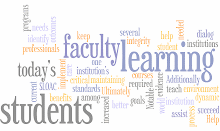Palomar College faculty and staff are now implementing the Outcomes Database, the software program that houses all of our Student Learning Outcomes, Service Area Outcomes, assessment plans, results, and action plans.
Faculty and staff can log into the database using their Palomar e-mail user name and password. Check out the faculty manual and a set of video tutorials for guidance on entering data and uploading documents. Click on the "Training and Help" link under the Outcomes Database menu on this page. For individual assistance, please contact us at learningoutcomeshelp@palomar.edu.
Wednesday, September 22, 2010
Wednesday, August 11, 2010
What do our students know about Learning Outcomes?
To find out, we conducted random interviews with students on the San Marcos campus. We stopped to chat with a faculty member, too.
We first asked students:What do you know about Student Learning Outcomes? Do your instructors talk about SLOs?
We first asked students:What do you know about Student Learning Outcomes? Do your instructors talk about SLOs?
Friday, January 22, 2010
Becoming Accredited: The Path to Proficiency and Beyond
The Accrediting Commission for Community and Junior Colleges uses a rubric to evaluate colleges' Program Review, Planning, and Student Learning Outcomes. There are four levels in the rubric for each area: Awareness, Development, Proficiency, and Sustainable, Continuous, Quality Improvement. The commission has stated that colleges be at the “Proficiency” level for Student Learning Outcomes by 2012. All colleges experiencing site visits - as Palomar College has in the last year and a half - and mid-term reports must show how the path to the proficiency level has been planned.What does “proficiency” look like on the ACCJC rubric? Here are the ACCJC descriptors:
•Student Learning Outcomes and authentic assessment are in place for courses, programs and degrees.
•Results of assessment are being used for improvement and further alignment of institution-wide practices.
•There is widespread institutional dialogue about the results.
•Decision-making includes dialogue on the results of assessment and is purposefully directed toward improving student learning.
•Appropriate resources continue to be allocated and fine-tuned.
•Comprehensive assessment reports exist and are completed on a regular basis.
•Course student learning outcomes are aligned with degree student learning outcomes.
•Students demonstrate awareness of goals and purposes of courses and programs in which they are enrolled.
Where are we with each of these points? What practices do we need to modify or adopt in order to reach proficiency? How do we see these interfacing with our strategic plan? As we continue to implement our SLOAC time line, it is imperative to address these questions in order for us to be at the Proficiency level by 2012.
•Student Learning Outcomes and authentic assessment are in place for courses, programs and degrees.
•Results of assessment are being used for improvement and further alignment of institution-wide practices.
•There is widespread institutional dialogue about the results.
•Decision-making includes dialogue on the results of assessment and is purposefully directed toward improving student learning.
•Appropriate resources continue to be allocated and fine-tuned.
•Comprehensive assessment reports exist and are completed on a regular basis.
•Course student learning outcomes are aligned with degree student learning outcomes.
•Students demonstrate awareness of goals and purposes of courses and programs in which they are enrolled.
Where are we with each of these points? What practices do we need to modify or adopt in order to reach proficiency? How do we see these interfacing with our strategic plan? As we continue to implement our SLOAC time line, it is imperative to address these questions in order for us to be at the Proficiency level by 2012.
Subscribe to:
Posts (Atom)
